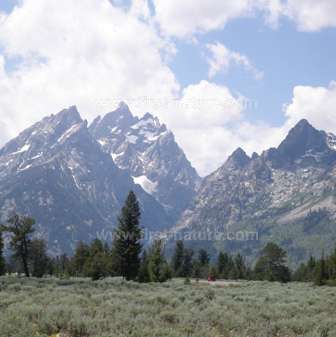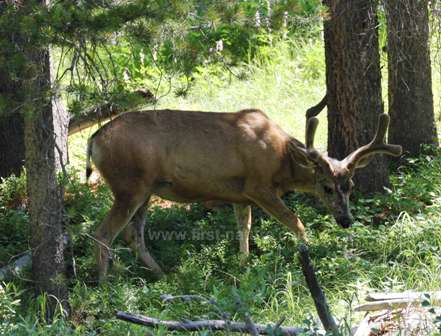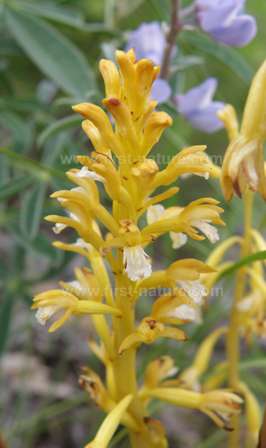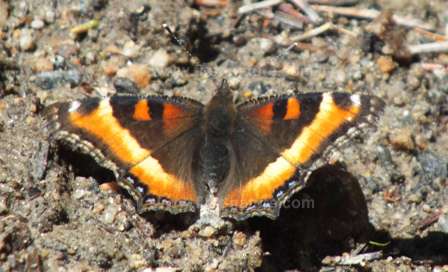Grand Teton National Park , Wyoming, USA
Wildflower species of the Grand Teton National Park.

Part of the breathtaking Grand Teton mountain range
Brief History of Grand Teton National Park
In Paul Schullery's excellent book Searching for Yellowstone he remarks upon the fiercely negative behaviour of people when confronted with the proposition that any land in and around where they live should be protected from development for the benefit of nature and wildlife. More often than not it is these very people who are the ones whose businesses benefit most from the influx of visitors that such protection encourages. So it was with Grand Teton National Park. Despite the obvious success of neighbouring Yellowstone National Park (the first National Park to be designated in the world, in 1872) in attracting a highly lucrative tourist trade to see its wonders - tourists who also visted the Tetons - the local folk still fought tooth and nail to prevent the federalisation of land in Jackson Hole.
The Teton area received its first government protection in 1897, when Congress created the Teton Forest Reserve. By 1918 Congressmen were fighting to extend the boundary southwards to include the northern part of Jackson Hole, but because of intense local opposition it was not until 1927 that the central peaks of the Teton range, as well as the lakes at their base, were included and the combined land area became Grand Teton National Park.
The newly created National Park was about one third of the size that it is today, and many feared that without further land being included within the boundaries of the Park unfettered development would take place and the magnificent mountain views would be spoiled. It took the intervention and immense generosity of John D. Rockefeller, who purchased 35,000 acres of land which he donated to expand the Park boundaries, to provide the final impetus that resulted in the creation of the National Park as we see it today.

An Elk forages in a quiet area of pine woodland in Grand Teton National Park
Long before the political wrangling by settlers over the Park's designation began, the area was used by various tribes of native American Indians, who gathered plants for medicinal and other purposes; the area also formed part of the annual migration trail for many of the large mammals that they hunted for food and for their pelts.
The rivers flowing from the Tetons were a source of rich pickings for trappers paid to hunt for Beaver to feed the fashion for Beaver hats - a trend which died out by the 1840s, resulting in the abandonment of the area by companies such as Hudson Bay and Northwest who had specialised in furs.
It was to be some 50 years before a another group of settlers arrived to populate the region, taking advantage of a special Act which granted each settler 160 acres of land free of charge provided they agreed to stay in the area for a minimum of five years. The land was poor grazing and all but useless for agriculture, and this coupled with the difficulty of supplying the area with the basic necessities of life meant that the settlers lives were full of hardship.

Skyrocket, Ipomopsis aggregata, is a comon wayside flower in Grand Teton National Park
Grand Teton National Park Today
Since the creation of Grand Teton National Park in 1950 tourism has grown to be the most important industry in Jackson Hole. In 1965 a major development to improve on the skiing and winter sports facilities around the town meant that tourism now provides the local community with a year-round income. An average of two and a half million visitors travel to the Park each year to enjoy the sublime mountain views and the outstanding wildlife of the area. There are numerous hiking, biking and walking trails throughout the Park. Other visitors choose to fish, take float-trips down the Snake River or go riding. Campsites and other accommodation are plentiful both in the Park and in the nearby town of Jackson Hole, where there are numerous hotels and restaurants.
The Flora and Fauna of Grand Teton National Park
When driving south from Yellowstone National Park and leaving behind its boiling springs and other super-hot geothermal features in early July (which is when we visited), there is a noticable change in the roadside wildflowers as you approach Grand Teton National Park. One of the of the most striking species to appear is Skyrocket, pictured right, which covers the roadside verges in great swathes of bright red. The beautiful star-like flowers also have a less attractive common name, Skunkflower, and this is reportedly due to a rank smell that emanates from the base of the leaves.

Western Spotted Coralroot Orchid, Corallorhiza maculata, flowering under pine trees on the side of the road.
In the higher parts of the Park, some of which can be reached only by hiking along the mountain trails, there are beautiful sub-alpine meadows full of flowers which persist well into July. Species to look out for include Mountain/Streamside Globe Mallow Iliamna rivularis, Mountain Kittentails Syntheris missurica, and the gorgeous Giant Red Paintbrush Castilleja miniata. Paintbrushes (of which there are several species growing in the Rocky Mountains) are partially parasitic on the roots of other plants growing around them; this makes them difficult to grow from seed or to transplant. Two other species appearing in the Park are Rosy Paintbrush Castilleja rhexifolia and Sulphur Paintbrush Castilleja sulphurea.
Wild orchids grow in various habitats in the Park. In the streamside damp meadows you will find White Bog Orchid Platanthera dilitata var. albiflora in June, and then slightly later in the season Hooded Ladies-tresses (also known as Irish Lady's-tresses) Spiranthes romanzoffiana appear. Also common and growing in similar habitas, is Green Bog Orchid Platanthera huronensis, which flowers slightly later than the White Bog Orchid. In the pine woodlands and on the edges of well-trodden paths you may be lucky enough to find several of the coralroot orchids: Western Coralroot Orchid Corallorhiza mertensiana and the Early Coralroot Orchid Corallorhiza trifida. Western Spotted Coralroot Orchid Corallorhiza maculata also occurs in the area. There are four 'forms' of this strange orchid and, shown on the right, is Corallorhiza maculata var. occidentalis f. immaculata which is thoroughly contradictory and means that it is a form of the Western Spotted Coralroot Orchid without spots!
Of the many birds that are recorded in Grand Teton National Park one of the great delights is the Osprey. Now so rare in the UK that they are the subject of various reintroduction programmes, these fish-eating birds are truly wonderful to see as they flying over the rivers and lakes. Ospreys raise their families in nests in dead trees along the rivers or on the purpose-built nesting platforms throughout the Park.
Raptors are particularly well represented in the Park, with Bald Eagles a relatively common sight along the edges of rivers, where they sit patiently in trees awaiting the arrival of an unsuspecting meal in the water below. More scavengers than hunters, Bald Eagles feed on the Park's many small mammals during the summer, switching to larger prey in winter once the smaller creatures have gone into hibernation.

A large rock makes an easy landing target for a young American Robin just learning to fly
Resident throughout the entire region is the American Robin. Much larger than the European Robin this bird is actually a member of the Blackbird family. It lives in woods, parks and gardens where, in summer, earthworms are its main food; in autumn the American Robin harvests the berry-laden shrubs which are plentiful throughout the area.
Grand Teton National Park lacks Yellowstone National Park's grand spectacles of large mammals, but complacency about close encounters with bears, Moose and Bison is not advisable. We saw a distant herd of Bison on a recent visit, got very close to an Elk Deer (see above) and saw several Moose, too. Conversations about Elk and Moose are confusing - in Europe the Moose is known more commonly as the Elk, and in America the name Elk refers to a deer species. The name Moose refers specifically to... well, a Moose!

Milbert's Tortoiseshell Butterfly
Insect life is prolific in summertime in the Rocky Mountains. The wonderful displays of wildflowers means that there are also plenty of butterflies and moths to be seen.
On one of our walks in a wildflower meadow in Grand Teton National Park we were surrounded by so many kinds of butterflies that we literally lost count: Milbert's Tortoiseshell, Clouded Sulphur, Mourning Cloak and Western Tiger Swallowtail vied with each other for our attention and stretched our photographic skills (and patience) to the limit.
Short visits to the national parks in the Rocky Mountains can never satisfy the curiosity of even amateur naturalists such as us, but if you do only have a short time to spend in Grand Teton National Park, there is an excellent circular drive with stop-off points that will take you to the best mountain views and give you a real feel for the place. If driving anti-clockwise start at Moose Junction and follow the road towards Moran Junction and then Jackson Lake Junction. From there follow around towards Jenny Lake Visitor Centre, but we strongly recommend including the diversion from the main road towards Signal Mountain viewing point, which offers a superb panoramic vista of the surrounding countryside.
Wildflowers in the Rocky Mountains States - Colorado, Montana, Wyoming
Scientific name |
English name |
Botanical Family |
|---|---|---|
| Anticlea elegans | Elegant Death Camas/Mountain Death Camas | Liliaceae |
| Aquilegia coerulea | Colorado Blue Columbine | Ranunculaceae |
| Aquilegia elegantula | Western Red Columbine | Ranunculaceae |
| Aquilegia flavescens | Yellow Columbine | Ranunculaceae |
| Argemone polyanthemos | Prickly Poppy | Papaveraceae |
| Asclepias speciosa | Showy Milkweed | Asclepiadaceae |
| Balsamorhiza sagittata | Arrowleaf Balsamroot | Asteraceae |
| Camassia quamash | Common Blue Camas | Liliaceae |
| Corallohriza maculata var. occidentalis f. immaculata | Western Spotted Coralroot Orchid f. immaculata | Orchidaceae |
| Corallorhiza maculata var. occidentalis f. intermedia | Western Spotted Coralroot Orchid f. intermedia | Orchidaceae |
| Corallorhiza trifida | Early Coralroot Orchid | Orchidaceae |
| Corallorhiza mertensiana | Western Coralroot Orchid | Orchidaceae |
| Dodecatheon pulchellum | Shooting Star | Primulaceae |
| Frasera speciosa | Green Gentian/Elk Weed/Monument Plant | Gentianaceae |
| Gaillardia aristata | Blanket Flower | Asteraceae |
| Gentiana parryi | Parry's Gentian | Gentianaceae |
| Gentianopsis thermalis | Rocky Mountain Fringed Gentian | Gentianaceae |
| Lilium philadelphicum | Rocky Mountain/Wood Lily | Liliaceae |
| Listera (Neottia) cordata var. cordata | Lesser Twayblade | Orchidaceae |
| Listera cordata var. nephrophylla | Western Heart-flowered Twayblade | Orchidaceae |
| Lithophragma parviflorum | Woodlandstar | Saxifragaceae |
| Minuartia obtusiloba | Alpine Sandwort | Caryopyllaceae |
| Pedicularis groenlandica | Elephant Head | Orobanchaceae |
| Pedicularis parryi | Parry's Lousewort | Orobanchaceae |
| Penstemon whippleanus | Whipple's Penstemon | Scrophulariaceae |
| Phacelia sericea | Purple Fringe | Hydrophyllaceae |
| Platanthera dilatata var. albiflora | Rein Orchid/White Bog Orchis | Orchidaceae |
| Platanthera dilitata var. leucostachys | Bog Candles/Sierra Rein Orchis | Orchidaceae |
| Platanthera huronensis | Green Bog Orchis | Orchidaceae |
| Platanthera hyperborea | Northern Rein Orchis | Orchidaceae |
| Platanthera obtusata | Blunt-leaved Bog Orchis | Orchidaceae |
| Ratibida columnifera | Coneflower | Asteraceae |
| Rhodiola rhodantha | Queen's Crown | Crassulaceae |
| Rholdiola rosea | King's Crown | Crassulaceae |
| Silene acaulis | Moss Campion | Caryophyllaceae |
| Spiranthes romanzoffiana | Hooded Ladies-tresses/Irish Lady's-tresses | Orchidaceae |
| Toxicoscordion venenosus | Meadow Death Camas | Liliaceae |
| Trollius laxus | Globeflower | Ranunculaceae |
| Yucca glauca | Soapweed Yucca/Spanish Bayonet | Agavaceae |